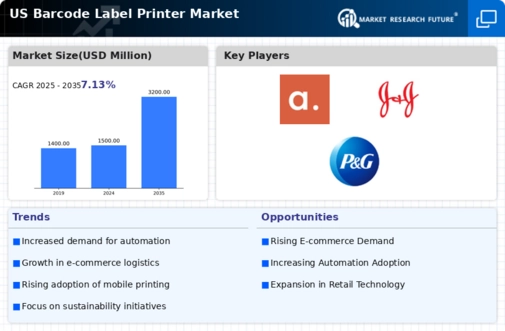Rising E-commerce Demand
The surge in e-commerce activities in the US has led to an increased need for efficient labeling solutions, thereby driving the barcode label-printer market. As online retail continues to expand, businesses require reliable and fast labeling systems to manage inventory and shipping processes. In 2025, the e-commerce sector is projected to account for approximately 20% of total retail sales in the US. This growth necessitates advanced barcode label printers for accurate tracking and management. This trend indicates a growing reliance on automated solutions, which enhances operational efficiency and reduces human error. Consequently, manufacturers in the barcode label-printer market are likely to innovate and adapt their products to meet the specific needs of e-commerce businesses, further propelling market growth.
Customization Needs in Retail
The retail sector's demand for customized labeling solutions is driving the barcode label-printer market. As retailers strive to enhance customer experience, personalized labels and packaging have become essential. In 2025, it is projected that customized products will account for over 25% of total retail sales in the US, prompting retailers to invest in versatile barcode label printers that can accommodate various label designs and sizes. This trend suggests that businesses are increasingly recognizing the value of tailored solutions in attracting and retaining customers. Consequently, manufacturers in the barcode label-printer market are likely to focus on developing printers that offer high levels of customization, thereby meeting the evolving needs of the retail industry.
Increased Regulatory Compliance
The barcode label-printer market is experiencing growth due to heightened regulatory compliance requirements across various industries in the US. Sectors such as pharmaceuticals, food and beverage, and logistics are subject to stringent labeling regulations to ensure safety and traceability. For instance, the FDA mandates specific labeling standards for pharmaceutical products, which necessitates the use of high-quality barcode label printers. As companies strive to meet these regulations, the demand for advanced labeling solutions is expected to rise. In 2025, it is estimated that compliance-related investments will constitute a significant portion of operational budgets, thereby driving the barcode label-printer market. This trend suggests that businesses are increasingly prioritizing compliance, which in turn fuels the demand for innovative labeling technologies.
Growth of Inventory Management Solutions
The increasing emphasis on efficient inventory management is significantly impacting the barcode label-printer market. Businesses across various sectors are adopting advanced inventory management systems to streamline operations and reduce costs. In 2025, it is estimated that the inventory management software market will grow by approximately 15%, leading to a corresponding rise in demand for barcode label printers that can integrate with these systems. This trend indicates a shift towards more sophisticated inventory tracking methods, which require reliable and efficient labeling solutions. As companies seek to enhance their inventory accuracy and reduce waste, the barcode label-printer market is likely to experience substantial growth, driven by the need for effective labeling technologies.
Technological Integration in Supply Chains
The integration of advanced technologies such as IoT and AI into supply chain management is influencing the barcode label-printer market. Companies are increasingly adopting smart labeling solutions that enhance tracking and inventory management. In 2025, it is anticipated that around 30% of supply chain operations in the US will utilize IoT-enabled devices, which require compatible barcode label printers for seamless operation. This technological shift indicates a growing trend towards automation and real-time data collection, which can significantly improve operational efficiency. As businesses seek to optimize their supply chains, the demand for sophisticated barcode label printers that can integrate with these technologies is likely to increase, thereby propelling market growth.













Leave a Comment